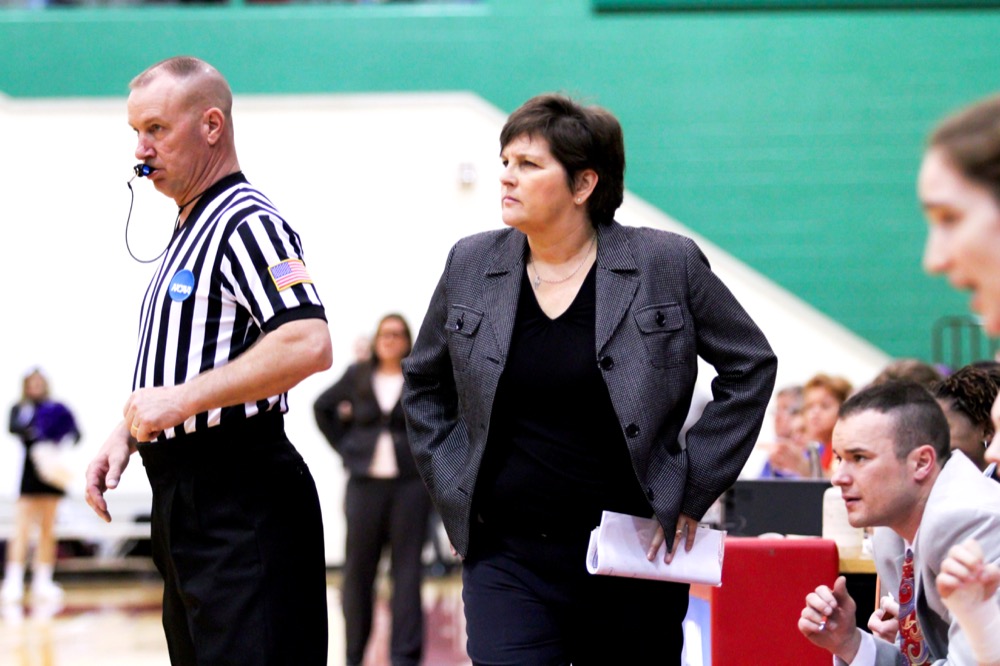There are about 82 steps between men’s basketball Coach Mark Edwards’s office and the unoccupied room on the other side of the court.
Eighty-two well-trodden steps.
Right now, that room is shuttered, the doors locked and the blinds drawn. You can’t look inside anymore, but if you traveled back in time and peered through the window, you’d probably see two things. First, a boatload of trophies. Second, a coach with a pedigree like few else in her sport.
Clik here to view.
 Stephen Huber | Student Life
Stephen Huber | Student LifeFormer women’s basketball coach Nancy Fahey watches her team during a 2016 game. Fahey recently departed Washington University to coach at Division I University of Illinois.
That person you’d see is, of course, Nancy Fahey, the legendary face of Wash. U. women’s basketball. Last Wednesday, Fahey was hired by the University of Illinois Urbana-Champaign as the head coach of its program, cutting short a 31-year career at the Field House.
News outlets from St. Louis to Chicago blanketed the story. Most of them found a way to include a couple choice statistics: 737 wins, 23 conference titles, 29 tournament appearances, 10 Final Fours and an NCAA Division III-record five national championships. She’s the fastest women’s basketball coach to 600 wins and the second fastest to 700 behind the University of Connecticut’s Geno Auriemma. Before winning 90 straight games in the late 2000s, Auriemma’s Huskies were chasing an 81-game winning streak reached by Fahey and her Bears.
When you achieve that level of success, people start comparing you to other people. The link to Auriemma is pretty obvious, but Chris Mitchell, the Bears’ associate athletic director for communications, has an equally lofty parallel.
“[Fahey] is the Pat Summitt of Division III basketball,” Mitchell said. Summitt is the women’s basketball coach with the most wins in all of NCAA history.
Through all Fahey’s success, plenty stayed the same—for example, the 82 steps between her and Edwards’s offices.
Edwards, a Wash. U. graduate, returned to the Danforth Campus in 1981. Since Fahey arrived a couple years later in 1986, the two have served as reliable rudders for Wash. U. basketball. In that time, there have been a lot of trips back and forth across a court that, as of 2015, bears both their names.
Fahey actually remembers her first time crossing the court.
Naturally, it was during her rookie year. Former Athletic Director John Schael had just hired her out of a high school coaching gig and she had no experience running a team at the collegiate level. So in that first meeting, Fahey and Edwards hashed out the basics: when she should schedule practices, how to do it around class time, how to manage the training room.
As Fahey found her footing, their meetings turned to the finer points of basketball. Sometimes they’d talk strategy. Other times they’d discuss how to connect with their players.
“If you watch our systems, it’s clear that I’ve stolen a few things [from Edwards] and I hope he’s stolen a few things back,” Fahey said.
Building on each other’s expertise, the two have set new standards for Wash. U. basketball.
“When we first started programs here, the basketball team was struggling to find an identity, to win a game, to even find out who we should be playing,” Edwards said. “Now we find our programs at the upper echelons of Division III and we find the expectations of winning championships to be routine.”
A week ago, Fahey made one last trip across the court. This time it was to ask for advice. With the Illinois offer on the table, she had to decide whether to continue building her legacy at Wash. U. or take on an entirely new challenge in the Big Ten. The content of that last conversation, understandably, stays between her and Edwards.
Anyone who’s ever watched a Wash. U. women’s basketball game knows that Fahey is an intimidating presence on the court—perhaps even more so than her players. Regardless of the opponent, regardless of the score, she is pacing up and down the bench, stomping her feet, aggressively sipping her water bottle and directing her players.
But Edwards has the perfect story to reveal Fahey’s character. The memory comes from the first weekend Fahey ever coached at Wash. U. It was 1986 and both the women’s and men’s teams were in Boston for a short tournament. Making that trip was Edwards, Fahey and legendary Wash. U. volleyball coach Teri Clemens, who was Fahey’s assistant coach at the time. Both teams were staying at a hotel near Harvard University.
Around dinner time, Edwards and Clemens wanted to go out to eat. The only problem was that they couldn’t convince Fahey.
“We couldn’t get Nancy to leave the hotel,” Edwards said. “She was scared to death to leave her team alone.”
Eventually, Edwards and Clemens got Fahey to relent. Since Fahey was the greenhorn, she had to drive the van. They started to explore the city, got on the highway, and the next thing they knew, “We saw a sign that said ‘Maine,’” Edwards recalled.
The three were very lost; to be fair, this was in an age before Google Maps. So Fahey turned the car around, they got back on the highway and finally came to a tollbooth.
“Since we were staying right off the Harvard campus, she asks the guy, ‘How do we get to Harvard?’ He says, ‘Study.’ He took our toll and off we went,” Edwards said, breaking out in laughter.